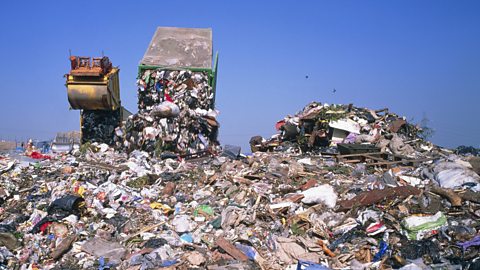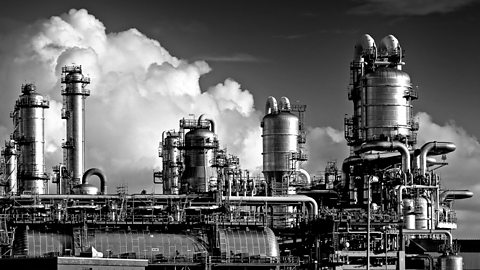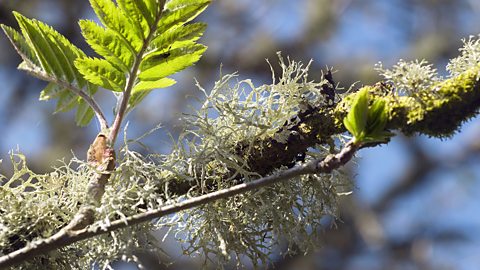Pollution
Increasing human population has led to an increase in pollution. Some of this is due to:
- more fossil fuels being burnt for heat and power
- more food being grown
- land taken over for industry and housing
Land pollution
The rubbish we throw out that is not recycledUsed materials that have been reprocessed to make new materials. goes into a land fill. These are huge holes in the ground into which our rubbish is dumped. Some things like batteries cannot be put into landfill sitesPlaces where refuse is buried underground. because of the toxic chemicals they contain. They must be recycled. Other land pollution comes when some people dump rubbish in public or other private places, often to avoid paying for it to be disposed of. This is called fly tipping and is illegal.

Air pollution
combustionThe process of burning by heat. of fossil fuels and other fuels releases carbon dioxide. This contributes to the greenhouse effectThe retention of heat in the atmosphere caused by the build-up of greenhouse gases. and the vast majority of scientists think this leads to global warmingThe rise in the average temperature of the Earth's surface. . It also releases sulfur dioxide and nitrogen oxides which can cause acid rain. Air pollution can also be caused by tiny particulates from smoke which can cause smogA type of pollution that is a mixture of smoke and fog.. Some of the most polluted cities are in Bangladesh, Pakistan and India.

Water pollution
Nitrate fertilisers are very soluble in water and are easily washed off fields by the rain and then into rivers and reservoirs. Because nitrates are all soluble, they cannot easily be removed from the water.
Pesticides used by farmers to kill weeds or insects may be washed or blown into streams and rivers.
Pollution indicators
The level of pollution in air or water can be indicated by the species living there. This is known as an indicator speciesThe presence, abundance or absence of these organisms provides information such as the level of pollution in the environment.. Data obtained using indicator species will only show if an area is polluted or not. Indicator species cannot measure pollution levels - only chemical analysis using electronic meters and laboratory tests can.
Water pollution indicator species
Some freshwater animals are very sensitive to oxygen levels, such as stonefly larvae and freshwater shrimps. If these animals are found in a river, it shows that the river is clean. However, some animals are adapted for surviving in polluted conditions, for example blood worms and sludge worms. Presence of these species indicates there is a high level of water pollution.
Question
In a sample of pond water there was a large number of water lice and red-tailed maggots. What does this tell you about the levels of pollution in the pond?
Water louse and red-tailed maggot are indicator species. They are able to live in water that is moderately to highly polluted. The pond must therefore be moderately to highly polluted.
Question
The species living in a pond were monitored over a period of ten years. The pond mainly had stonefly nymph living in it at the start of the ten years. By the end of the ten years, almost all the stonefly nymph had gone. Explain what has happened to stonefly nymph.
Stonefly nymph can only live in clean water. As the ten years went on, the pond must have become more polluted. This killed off the stonefly nymph or they went to lie in a cleaner pond.

Image caption, Bushy lichens need really clean air
Image caption, Leafy lichens can survive a small amount of air pollution
Image caption, Crusty lichens can survive in more polluted air
1 of 3
More guides on this topic
- Field investigations - OCR Gateway
- Feeding the human race - OCR Gateway
- Monitoring & maintaining health - Communicable diseases - OCR Gateway
- Treating, curing and preventing disease - OCR Gateway
- Monoclonal antibodies - Higher - OCR Gateway
- Plant disease - OCR Gateway
- Cancer and cardiovascular disease - Non-communicable - OCR Gateway
- Monitoring and maintaining health - Non-communicable - OCR Gateway
- Sample exam questions - global challenges - OCR Gateway